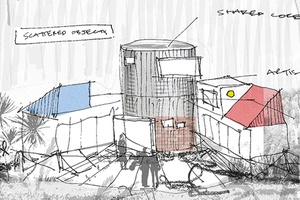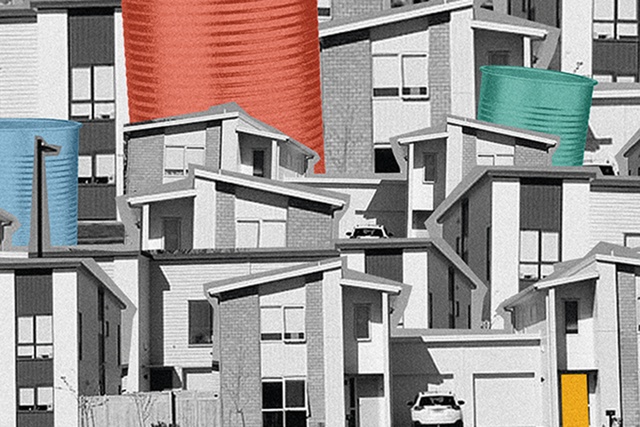The line between good and bad
Architects and the profession seem, continually, to demand beauty in buildings: those downpipes are ugly; that joinery is ugly; and that façade is... ugly. The line drawn between good buildings and bad buildings can often be one of aesthetic merit.
Reader, I had another column planned and partly written about how I had received a letter, and how it had spurred on questions for me about academic and artistic freedoms and the conceptual frameworks we have for building community. Already, as I write those words “academic and artistic freedoms”, I feel as though it might be just as well the writing moved away from that. I might subject you to it later so it’s not completely off the table.
For that abandoned column, I thought to ask a student, now enrolled in the Masters (Professional) of Architecture programme, for images from their studio project ‘Room for Rellies’ to accompany the text as the project had stayed with me since attending the crit in 2020. If I were to label what had remained and why, it was the point of view meets references meets architecture. If I were to inspect my lasting impression, it is the very visceral link between a younger generation and what they are to inherit and, in my view, the justified fingers to the state of both housing design and supply. But who are the people behind the state of both? Who, exactly, is getting the fingers here? I found myself wanting to try and answer this question.
Most of the housing supply that one can see going up or that has already been completed can be confronting — and not in a good way — in its architectural and overall contribution to the urban fabric. Sometimes, when I drive past some of these developments, I wonder if such proposals would pass an architectural studio.

Simultaneously, I am cognisant that the appraisal of a non-practising academic driving past, one eye on the road, is probably not the fairest one. Although, even if I have more time on my hands, I stand at a distance from some of these housing developments, curious about what my eyes are looking at. Could they truly be this… fugly?
It presents one with a metaphysical conundrum: why can’t things be more beautiful? This abstract query levelled at these developments can be quickly balanced with other critical questions also needing answers: How has the quality of living been improved for tenants post- occupancy? Do these developments improve access to infrastructure and amenities? Are these dwellings contributing to overall housing affordability, thereby likely improving access for the most vulnerable communities? What should I trust to the field of visual perception, and what should be entrusted to research, planning, policy, council, construction and economics?
Architects and the profession seem, continually, to demand beauty in buildings: those downpipes are ugly; that joinery is ugly; and that façade is… ugly. The line drawn between good buildings and bad buildings can often be one of aesthetic merit. Although, in my experience, what is qualified as aesthetically meritorious by architecture and its industry is often, if not always, bound up in class, capitalism, social hierarchies and world view. Beauty is not only a way of wielding power but a way of keeping it. And yet, to me, the metaphysical pleasure of beautiful space and architecture is an internal experience that realigns the self with vitality and an aspiration for the soul. It is an education.

Can we learn something at this crossroads of an industry that over-serves the wealthy and an industry that can so powerfully address inequity? American essayist and Walter M. Cabot Professor of Aesthetics and General Theory of Value at Harvard University, Elaine Scarry, describes in her own argument about beauty, the way in which I feel architecture manifests beauty experientially: “The beautiful, almost without any effort of our own, acquaints us with the mental event of conviction, and so pleasurable a mental state is this that ever afterwards one is willing to labor, struggle, wrestle with the world to locate enduring sources of conviction — to locate what is true”.1
Situated within a larger (and beautiful) argument that the human reaction to beauty can extend beyond a surface appreciation, it can be, in fact, a call to justice. Scarry claims beauty is a — if not the most — fitting candidate to call us to an ethical existence, not just for the individual but for society. Beauty is not just the experience of pleasure, it is a threshold and to step over that threshold is to undergo a radical decentring, whereby beauty can “lift us (as though by the air currents of someone else’s sweeping), letting the ground rotate beneath us several inches so that when we land, we find we are standing in a different relation to the world than we were a moment before. It is not that we cease to stand even at the center of the world, for we never stood there. It is that we cease to stand even at the center of our own world. We willingly cede our ground to the thing that stands before us.”2

When I read these words, I am filled with the sense of peace that comes when one’s experience is put into words by another. The architecture that attends to beauty in its many social, cultural and political manifestations returns me to the threshold, as if I have returned to myself, empowered to do better in the world, to move towards justice. This is not for moral high ground; no, because, if beauty is attainable, then so is equity. Is this not the hope for housing, and beyond housing? Is it not the hope for our built realm?
For the next generation, I understand both the intense frustration at what is being produced and the conditions under which such productions are occurring. Are fugly buildings produced by fugly acts of financial gain made possible by fugly politics and injustice that we have passively watched go by? This, if it is (and it often feels overwhelmingly so) true, definitely deserves the fingers.
I feel a bit frustrated and maybe even exhausted to arrive here, battling to conclude this column without just throwing my hands up and distracting myself with some scrolling. But then part of me remembers Scarry’s version of beauty with its radical power to steer us towards justice. If so, then it is not just a symbolic effort the profession pursues to create and critique where there is an absence of beauty; in this way, there is political weight to keep desiring it for our housing. And so, I rethink my earlier train of thought and come at it again in a way that bolsters conviction; beautiful buildings can produce more just economics and politics, and they can locate what is true.
References
1. Elaine Scarry, On Beauty and Being Just. The Tanner Lectures on Human Values, delivered at Yale University, 25 and 26 March 1998.
2. Ibid.









